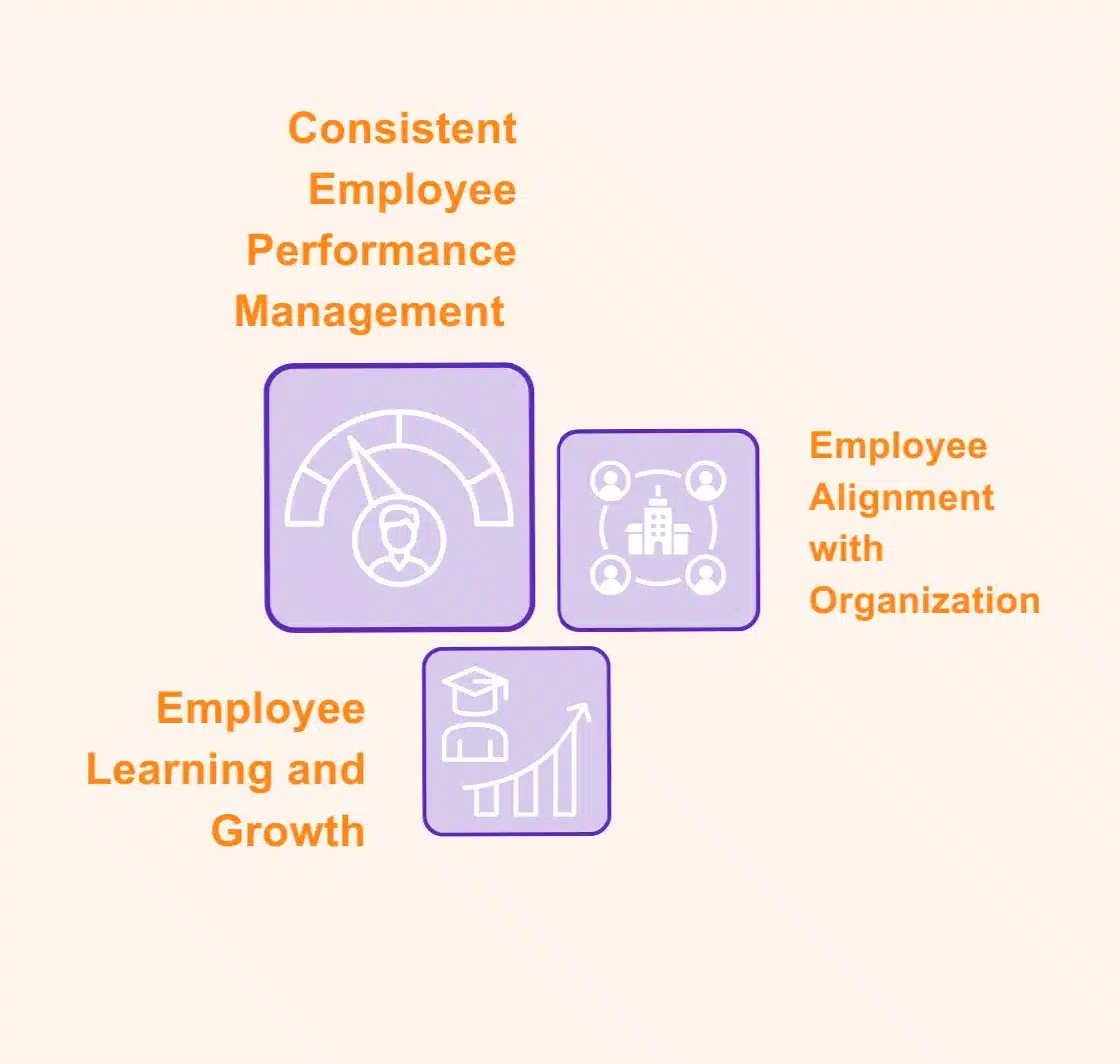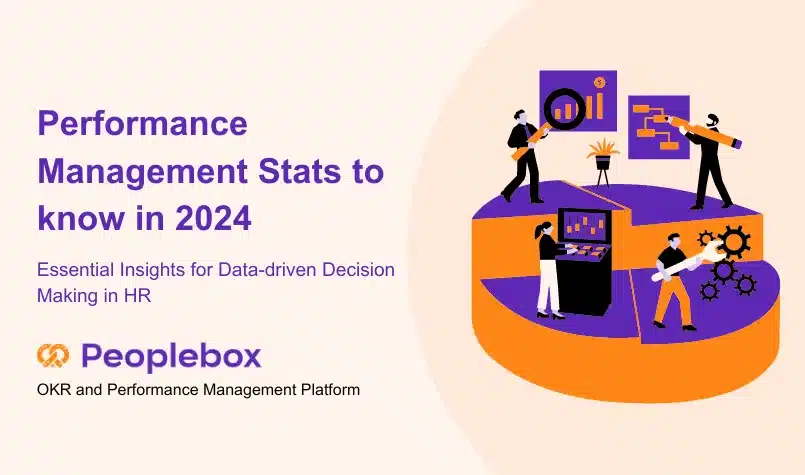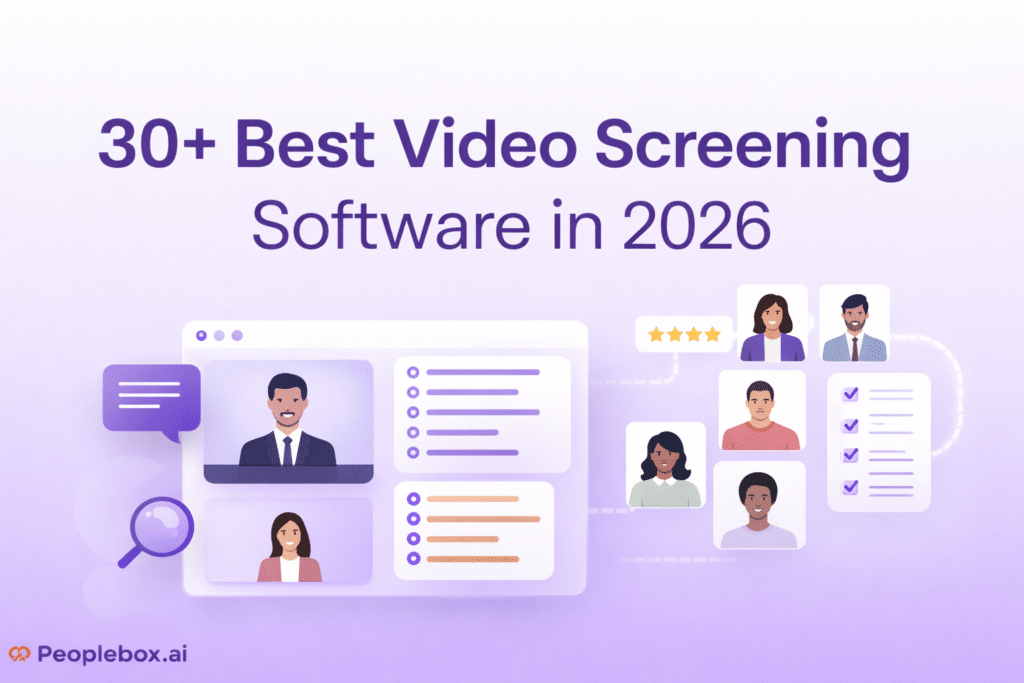Discover the key to great performance management in 2026 with our list of key statistics from the last five years.
These numbers show where we currently stand, highlight the biggest bottlenecks, and show what strategies truly work.
Whether you’re a manager looking to improve team performance or an HR professional aiming for better processes, these data-driven insights will guide you to success.
Performance Management Statistics

Let’s examine data on current trends, business impact, key challenges, and solutions.
We’ll also look at results from companies that have integrated AI into performance management practices.
Performance Management Statistics: Current Practices and Trends
Looking at current performance management practices helps us see where we are and notice areas to improve.
This section covers statistics on everything from priorities and design philosophies to goal setting and performance evaluations.
Organizations’ top three performance management priorities are:

- Helping employees align their work with organizational needs and priorities (49%)
- Assisting managers in holding employees accountable for achieving performance expectations (46%)
- Supporting employee learning and growth (35%)
The top three performance management design philosophies for organizations are:
- Driving a consistent employee performance management experience (45%)
- Empowering employees to meet unique development needs (22%)
- Empowering managers to use discretion in performance management (17%)
Nearly all organizations have formal policies for:
- Setting performance expectations (90%)
- Providing performance feedback (83%)
- Conducting formal performance reviews (83%)
Goal setting:
- Across all industries and job types, the most common type of performance goals for employees are individual goals (58%), followed by team goals (36%) and customer goals (19%).
- Many managers set individual goals in isolation, without aligning them with broader business unit or company priorities. Globally, 83% of companies set individual goals, but only 56% require business unit goals.
- Individual goal setting has not caught up with today’s team-based work, with only 9% of organizations involving peers and 15% involving teams in goal setting.
- Only 44% of employees report updating their goals after significant changes in role expectations, such as sudden staff changes or the assignment of new projects.
- Employees involvement in goal setting is low, even though it is useful:
- Less than one-third (30%) of employees strongly agree that their manager involves them in goal setting.
- Employees whose managers involve them in goal setting are 3.6 times more likely to be engaged.
- Only 21% of employees strongly agree they have performance metrics that are within their control.
Evaluating performance:
- Employees report that their performance evaluations are most often based on their manager’s observations (67%) and performance ratings (54%).
- Companies rarely conduct 360-degree reviews; only 17% of employees are evaluated by their teams, while 99% are assessed by their direct managers.
- When evaluating performance, nearly all organizations (94%) assess if employees’ behaviors align with company standards and norms. However, just 17% give two separate ratings for outcomes and behaviors in their performance reviews.
- Only 19% of employees strongly agree that focusing on weaknesses motivates them to do outstanding work.
- 86% of organisations incorporate ratings into their performance review process.
- Only 5% of organisations that currently use ratings are planning to eliminate them soon.
Annual reviews:
- Over three-quarters (76%) of organizations rate their employees once per year.
- Annual review cycles are costly for organizations. For an organization with 10,000 employees, performance evaluations can result in lost working hours valued between $2.4 million and $35 million per year.
Performance-based remuneration:
- 81% of organizations adjust pay based on individual performance to drive higher performance.
- 48% of organizations allocate resources to pay differentiation analysis, while only 26% focus on performance analysis.
- Half of the organizations provide managers with guidelines for making pay differentiation decisions, but only 32% specify the extent of differentiation managers should achieve.
- About half of the organizations combine senior leadership oversight with pay differentiation analysis to ensure consistent and fair pay-for-performance decisions.
81% of HR leaders are implementing changes to performance management, yet they remain uncertain about the impact.
Performance Management Statistics: Connection Between Feedback, Employee Engagement, Performance, and Business Success
Moving forward from current trends, let’s look at how performance management, employee engagement, and organizational success are interconnected.
- Impact of meaningful feedback on employee engagement:
- Meaningful feedback boosts employee engagement by four times.
- 80% of employees who report receiving meaningful feedback in the past week are fully engaged.
- However, only 16% describe their last conversation with their manager as extremely meaningful.
- Employee belonging and engagement is strongly linked to performance:
- 93% of professionals agree that belonging drives organizational performance. This is one of the highest rates of consensus seen in ten years.
- Business and work units in the top half for employee engagement more than double their chances of success compared to those in the bottom half.
- Organizations in the top 1% for employee engagement had nearly five times the success rate of those in the bottom 1%.
Related read: Latest Employee Engagement Statistics in 2024
Performance Management Statistics: Key Challenges
When done correctly, performance management can have a huge impact. However, HR leaders recognize that current systems are falling short.
This section covers the issues with current systems, employee dissatisfaction, and the need for better manager skills.
- HR leaders recognize that performance management is falling short, with 82% saying it isn’t meeting primary objectives and 62% saying it isn’t keeping pace with business needs.
- Only 2% of CHROs from Fortune 500 companies strongly agree their performance management system inspires employees to improve.
- Employees echo this sentiment, with only one in five reporting that their performance reviews are transparent, fair, or inspire better performance.
- Less than one-third (30%) of employees believe their managers are fair in performance evaluations .
- Less than half (47%) of employees strongly agree they know what is expected of them at work.
- HR’s two most common complaints about performance management:
- 38% find the process too onerous
- 29% say it is time-consuming
- Many managers lack essential skills:
- Four in 10 admit they have not reached an advanced or expert level in team engagement or performance management.
- 6 in ten managers say they are not advanced or expert in developing employees and helping them create career paths.
- Yet, the majority of managers receive little feedback on how effectively they manage their team:
- Only 42% of U.S. employees report having the opportunity to formally provide feedback to their manager.
- Only 24% have formally rated their manager’s performance.
- Managers also lack sufficient support from their peers. Only about a third (36%) of managers say they receive feedback from their peers as part of a formal feedback process.
Performance Management Statistics: Key Strategies for Success
While challenges persist, effective solutions are available. Key approaches include frequent feedback and seeking input from various sources.
Aligning employee goals with company priorities, involving employees, and integrating AI can greatly improve the effectiveness of your performance management processes.
- Implementing these three key strategies can increase performance management utility, i.e how useful and effective your performance management process is, by 37.5%:
- Business-driven: HR customizes performance management components to align with business needs, resulting in a 10% increase in utility.
- Employee-owned: Shifting performance management ownership to employees, allowing them to drive evaluation, design, and implementation, resulting in a 19% increase in utility.
- Work-centered: Modifying performance management to facilitate collaborative work, leading to an 8.5% increase in utility.
- Impact of increasing performance management’s utility:
- 7% increase in the percentage of high performers.
- 14% increase in engagement.
- 24% increase in workforce performance.
- 50% increase in the perception of performance management fairness and accuracy.
- Aligning business and employee goals:
- Aligning employee goals with both organizational and employee needs can boost employee performance by up to 22%.
- Managers effective at contextualization—connecting business goals to employee goals and actions—can significantly boost performance, increasing the percentage of high performers from 44% to 60%.
- High-performing HR teams align HR governance and strategy with the overall business strategy four times more than low-performing teams (66% vs. 16%).
- More than 65% executives agree that metrics need to shift from capturing outcomes rather than outputs.
- Making performance reviews forward-looking, which means focusing on future organizational needs and the employee’s career growth, can increase employee performance by 13%.
- Peer evaluations lead to a 3.5% improvement in performance management utility and a 14% boost in employee performance.
- Continuous performance management
- Quarterly progress check-ins make employees 90% more likely to be engaged and 2.1 times more likely to perceive the performance management process as fair and transparent.
- Employees are 3.6 times more likely to feel motivated to excel when their manager provides daily feedback instead of annual feedback.
AI in performance management: Several companies have successfully integrated AI into their performance management processes using Peoplebox.ai, making the process easier and saving significant time.
- A rapidly growing fintech company Khatabook saved over 1,000 hours of team bandwidth and achieved 100% on-time completion of performance reviews.
- A leading enterprise communication platform CometChat achieved a 90% reduction in admin work.
- A technology-driven B2B service provider Ula saw a 70% reduction in HR’s mundane tasks and a drop in queries on Slack from 100% to 1.25% between review cycles.
Conclusion
Effective performance management is key to employee engagement, productivity, and organizational success. But inefficient processes get in the way.
To get better results, align goals to business objectives, give feedback more often, and use multiple sources for evaluation. AI can make these tasks easier and quicker.
Try our all-in-one AI performance management tool Peoplebox.ai.






